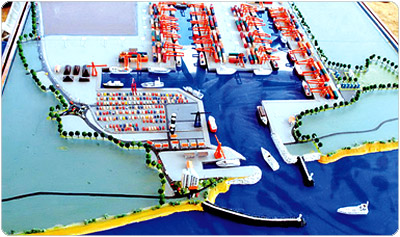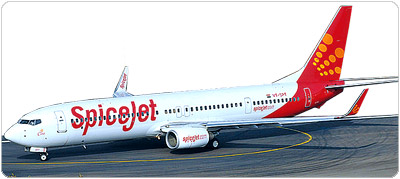Peace, stability lead to economic growth
By Sureka GALAGODA
|

Artistís impression of the Hambantota port |
The year 2010 ushered in peace and prosperity
to the nation with President Mahinda Rajapaksa winning the election with
a two-third majority. It was just months after winning the war against
the most ruthless terrorists in the world. His able guidance and
leadership as well as his strong will enabled all of us to stand under
one flag and proudly say that we are Sri Lankans.
The political and economic stability created in the country
overflowed to other areas with all sectors recording growth as never
before. The Colombo Stock Exchange (CSE) created history with the All
Share Price Index (ASPI) closing above the 5,000 level for the first
time in history on July 28. The ASPI closed the day at 5,138.9, gaining
139.8 points (2.8%). The Milanka Price Index (MPI) gained 159.5 points
(2.8%) to close the day at 5,828.7, also recording the highest in
history. The total turnover recorded during the day was Rs. 3.2 billion.
The market capitalisation at the end of the trading day was Rs. 1.68
trillion, the highest market capitalisation recorded in the history of
the CSE.The ASPI has gained 1,753.3 points (51.8%) for 2010 to date
while the MPI gained 1,979.3 points (51.4%). According to Bloomberg
News, the performance of the ASPI has led to the CSE being ranked the
second best performing stock exchange in the world for the year to date.
The CSE was named the second best performing Stock Exchange globally as
well.
Though the CSE is creating history, elsewhere in Asia the situation
is very different. According to analysts, the main reasons are the
economic and political stability as well as the peaceful situation in
the country which attracts investors to the stock market.
The CSE has become a booming stock exchange following the restoration
of political stability with the end to the 30-year conflict in the
country. The two public issues of Namal Acuity Value Fund and Hemas
Power were oversubscribed within the first day of the issue. Hemas Power
offered the IPO to raise Rs.600 million or more and was oversubscribed
at Rs. 20 per share by 10.30 am. It subscribed 84,221,100 shares valued
at Rs. 1, 683,788,500.
Market analysts said that the strong performance in infrastructure
development and the growth potential in the economy in the post-conflict
situation reflect this interest of investors.
Peace and stability are key to the growth of any economy, though the
country enjoyed political stability under the leadership of President
Rajapaksa exploring our full potential was not possible due to the
conflict which continued for over two decades and the negative publicity
given to all incidents in the country. Winning the war pumped in
confidence to all sectors as well as the international community and
proved that the island nation is capable of many a feat under the able
leadership and guidance of President Rajapaksa.
Global crisis
Sri Lankans didn't feel the pinch of the global crisis seriously due
to the far-reaching policies of the President and his team including the
Api Wawamu Rata Nagamu campaign which has instilled a culture of
self-sufficiency.
As predicted, even if the world undergoes a food crisis, Sri Lankans
will have food as the President believes that our prosperity lies in
agriculture.
In a speech after the historic win, President Rajapaksa said that our
country will develop its own model of economic development based on a
strong agricultural sector and not follow the existing Western models in
which industrial growth gets precedence. "If you can be self-sufficient
in food, then the industries will come," said President Rajapaksa in an
interview with the Forbes magazine. "Without development, there won't be
peace; we must develop the economy," he stressed.
President Rajapaksa said that even during the conflict, the Lankan
economy grew by at least six percent each year (though global recession
cut that to 3.5 percent to 4.5 percent in 2009). Inflation is now down
to 1.1 percent, from 11 percent four years ago, according to Central
Bank figures. He noted that per capita income had risen from $1,200 to
$2,000.
The reduction of lending rates by the State banks under a directive
of the President will help the businessman to expand his business and
also a person who wants to build a house or purchase a car.
This initiative will pave the way for rapid development in the
country be it in infrastructure, manufacturing or services.
As the North and the East have been liberated from the LTTE, several
programs to uplift the living conditions, generate employment and growth
have been initiated by the people-friendly President who has learnt to
address the people of the North and the East in their language which
bridges the gap and changes their mindset to think as Sri Lankans.
Infrastructure development
The Government has concluded the first phase of the Hambantota Port
construction and the first ship will sail mid-November. This project
will not only bring revenue but also convenience and time savings for
the factories in the Free Trade Zone in Koggala and outside the zone as
they could transport the goods in double quick time and win the
confidence of investors. President Rajapaksa won support for three major
development projects in Sri Lanka during his visit to China. Among them
are the Norochcholai Coal Power Plant, Hambantota Port and the
construction of a fully-equipped cultural centre.
Within six months of the visit. Chinese President, Hu Jintao took
steps to grant US $ 400 million for construction work of the
Norochcholai Coal Power Plant and the construction work of the cultural
centre was also initiated with a grant of US $ 100 million.
These development projects will provide new career opportunities for
20 million Sri Lankans and would be a boost to the Government's efforts
to reach its economic targets.

The initial work on the Mattala airport considered to be one of the
largest development projects in the Southern Province has also started
under the guidance of President Rajapaksa. Work on the US$125 million
project is scheduled to be completed soon.
The port, airport and the southern expressway will help improve the
living standards of the people in the Southern region and correct the
imbalance of the Colombo-centric development. Today people have hopes of
a better tomorrow under President Rajapaksa's stewardship. He has
attracted investments to the country and among them are the MAS Fabric
Park (MFP), the world's first environmental sustainable apparel and
Fabric park which accommodates the first warp knit project in South Asia
and offers shared services such as plug and play which is located at
Thulhiriya.
After the President took office, Foreign Direct Investment (FDI) has
seen a continuous rise and it is estimated that the Country will get US$
1000 million as FDI this year and the Board of Investment (BOI) is
confident of reaching the target by December while it is estimated the
country will get US$ 1200 mln as FDI next year.
The Government is set to attract more investment from Japan and
recently President Rajapaksa met Corporate President of Noritake Group
of Companies Hitoshi Tanemura. He thanked President Rajapaksa for the
unstinted support and cooperation extended to Noritake Lanka by the
President in 1994 during his tenure as the Labour Minister at a time the
company faced a severe labour unrest.
The "Jetliner", earlier used by the Sri Lanka Navy, now docked at the
Colombo Port, is designed to accommodate 600 passengers and 160 vehicles
at a time. The vessel has undergone complete refurbishment, providing
facilities for events such as weddings, corporate functions, meetings
and social gatherings.
SAs the global economy would emerge in the recession, it is envisaged
that Sri Lanka would record a 6.3 percent GDP growth rate that is second
only to China, which will record an 8.6 percent growth in the Asian
region.
The opening of the North and the East has helped Sri Lanka become a
popular year round tourist destination. The season for the South and
South West is from November to April and the season for the East and
North East is May to October.
The air of confidence has attracted many airlines to restart or
commence flights to and from Sri Lanka. Among them are Gulf Air,
Spicejet and Fly Dubai. Fly Dubai, Dubai's first low cost airline,
started its flights from June and operates four times a week to Sri
Lanka.Gulf Air, the largest Middle East international network
re-launched its services to Sri Lanka, after a lapse of five years. Gulf
Air will operate five times a week making a historic re-entry.
Spice Jet, the low cost carrier from India, also launched its
services as the second international destination and is scheduled to
increase the number of flights as well as the destinations it flies to
in the coming months.
Budget
The Mahinda Chinthana policy of the Government has identified certain
sectors to be developed for the country to become a knowledge and
financial hub.
To achieve this target the Budget will lay special emphasis on the IT
BPO sector and the telecommunication sector. Another thrust area is
agriculture and livestock, to be self-sufficient in food and liquid milk
as well as other dairy products. The Government is encouraging people to
have large farms.
Any product with local value addition will be protected from undue
international competition by way of incentives. As the Government's
vision is to make Sri Lanka an international trade hub certain tax
revisions will be carried out to make it a reality. He said that the
Government is looking at many options.
The government will take steps to protect local industries but in the
event there is no comparative advantage in manufacturing the product
locally, the Government will have to import such items. In this instance
too there will be a mechanism to protect them. |

